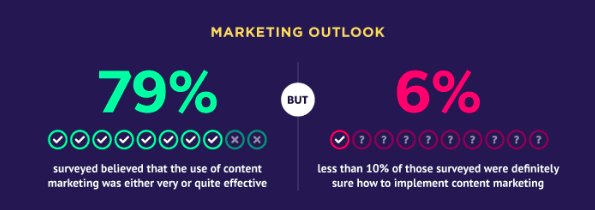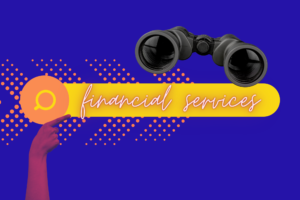Table of Contents
Last Updated on April 23, 2019 by admin
Fintech companies are increasingly relying on content marketing as a manner of growing brand awareness, bridging knowledge gaps, and generating leads. Since an inherent outcome of effective content marketing is trust-building, it’s become a critical strategy for smart marketers within fintech companies.

Another good reason many fintech (and other) organizations are turning to content marketing? Beyond building awareness, it boosts ROI — content marketing delivers more than 3x as many leads as traditional marketing, dollar for dollar.
Fintech growth hacks are another popular way for businesses — particularly startups — to rise above the competition on a shoestring budget. With fintech growth hacks, the focus is on using clever tactics in order to achieve fast-paced growth. There are many content marketing tricks and tactics that fall under the growth hacking umbrella, all of which aim to quickly move people through the buyer’s journey. The great thing about content marketing growth hacks is that they pair shrewd marketing tricks with trust-building strategies, a sure-fire recipe for new business and great ROI.
Here are 3 fintech growth hacks you can incorporate into your content marketing strategy to improve your conversion rates:
1) Use Video to Convey Transparency and Authenticity
One of the biggest challenges fintechs face is effectively conveying the value proposition of the services they offer. Complex technologies that solve complex problems can be difficult to boil down to an easily digestible information. Unfortunately, easily digestible information the best bet for grabbing attention and driving awareness around your brand in the first place. While white papers and in-depth ebooks are great bottom-of-the-funnel content that can help move your audience closer to a conversion, they are often too bulky for easy brand building.
Video is a great tool to grab attention and begin the education process around your products and services. Video as a media type is poised to account for more than 80% of all web traffic by 2019. Why? Because it’s interesting and digestible. Also, if you think video only impacts awareness and has little bearing on actual sales, think again: Marketers who use video grow revenue 49% faster than non-video users. Consider the following types of videos for a variety of marketing purposes:
- Explainers – ideal to present a digestible version of your unique selling proposition; explains your company’s product or service and the benefits to the user
- Vlogs – great alternative to written blog entries; can be done on a variety of fintech topics as a snackable snippet of relevant topics and news
- Social – great shareable assets that are shorter than traditional videos and live well on social platforms; makes sharing easy to increase reach of brand awareness
- Webinars – repurpose your live-stream webinars that people can download or view on YouTube or another video hosting platform
- Whiteboard – popular format to explain an interesting topic or solution to a problem; also features a real human, which can convey authenticity and build trust
- How-To’s – these illustrate how-to do something, whether it’s using your product or service or another neat trick you want to share with viewers.
Using video to hone down your unique value proposition can have benefits for your brand at every stage in the funnel. It enables your audience to better connect with you, which facilitates trust. Demo videos can also help illustrate exactly how your product or service works in an engaging way. The level of trust and transparency that video is capable of providing is a huge boost for any fintech company.
2) Create High-Quality Content Assets for Download
Video is among the top awareness-building fintech growth hacks. But you’ll also need content to entice visitors into giving up some of their information. For B2B fintechs, lead generation is an important strategy for growing the business. Effective lead generation is built on even trades: your audience gets a useful piece of content in exchange for providing their name, email address, and possibly a phone number.
Where many fintechs fall short is in regularly producing this type of high-quality content asset. Researching, writing, and designing a white paper is time-consuming and laborious. Without a fully-staffed content marketing department, many cobble together writings from busy executives who don’t have the bandwidth to give it their full attention. Worse yet, they abandon ship.
Don’t be like them.
Whether you work with a consultant or contract out this important work to an agency, get it done. Some ideas for building high-quality downloadable assets:
Build the foundation to a white paper
Brainstorm around a big industry problem your product addresses or solves. Create an outline that:
- a) introduces the industry challenge
- b) provides data and statistics to support why this challenge is a significant problem for your audience
- c) outlines some solutions to this challenge
- d) points out reasons your solution is the gold-standard to solving the problem
Consider supporting infographics
White papers are often dense, so adding some visual elements is a must. Since your white paper should be grounded in fact and statistics, consider turning some of those into an appealing infographic. An added bonus is that infographics are great tools for sharing content on social media. You can use the infographic to promote the ebook across channels and gain additional exposure.

Create a killer landing page
Every downloadable asset needs a landing page. It should include:
- A headline
- A sub-head
- Body copy
- A compelling call-to-action (CTA)
When it comes to landing pages, short and sweet is the rule. Tease out the value of your white paper in the headline and use bullets in the body copy to lay out exactly what visitors can expect within the white paper. When adding a form to the page, only ask for the essential information (name, email address, maybe a phone number). The longer the form, the greater the chances of your visitor abandoning the process. Also include a check box to opt-in to your newsletter, if you have one.
Nurture, nurture, nurture
The visitor has filled out the form and downloaded the asset. All done, right? Wrong. Now that you have an email address, send these visitors a drip sequence of emails over a couple weeks. Here’s an outline of a sample sequence:
- “Thank you for downloading. Here’s your white paper” with a link to the asset.
- “Hope you enjoyed ‘White Paper X’. Isn’t it interesting how [specific snippet from white paper]? We recently wrote a blog on why that’s interesting [link to blog].
- Same as above. Covers different talking point. Links to different web content.
- Same as above. Covers different talking point. Links to different web content.
- Same as above. Covers different talking point. Links to different web content. Includes subtle language around how [your company] helps solve the problem described
- Same as above. Covers different talking point. Links to different web content. Includes subtle language around how [your company] helps solve the problem described. Includes case study and asks for a meeting.
There are plenty of tools that allow you to set up an automated sequence like this. Consider MailChimp, HubSpot, or SharpSpring.
The idea is to continue teasing out helpful information to this engaged audience. As you get further on in the sequence, you may consider adding in more about your company and how your solutions work. Be subtle. Be elegant. Be creative.
[BONUS: Get the Definitive Guide to B2B Content Marketing here for additional ideas on ideating, creating, and promoting excellent lead generation content.]
3) Guest Blogging
Guest blogging on high-authority websites relevant to your niche is one of the several fintech growth hacks that shouldn’t be overlooked. This type of outreach can present your high-quality thought leadership to new and unique audiences. In addition to expanding the reach of your content marketing, it has excellent benefits for SEO. The backlinks earned from sharing your content on high-authority sites makes you more relevant, and subsequently more findable by people searching online.
Do your homework and create a list of online publications in which you’d like to have your fintech’s content featured. Since most publications ask for an outline of your proposed piece, be sure to have that ready to send. It’s really as easy as that. You will probably not get published by every place you reach out to and it may take several dozens of emails to obtain a placement. Don’t give up. Once you build a well-oiled outreach machine, you’ll have a sound method for obtaining new backlinks and presenting your best ideas to fresh audiences. While maintaining a blog on your own website is critical, guest blogging provides a way to get in front of new niches through other sites that already have a strong readership.
Fintech Growth Hacks: A Way to Get Ahead
B2B fintech investment is on the rise. In fact, a recent report by McKinsey & Co. has estimated that the size of the global payments industry is expected to grow to $2.2 trillion by 2020. Many companies are gunning for a slice of that pie, making for a crowded marketplace. The fintech growth hacks above are key ways you can stand apart from the competition.
Go beyond traditional marketing measures and engage with your audience through with content marketing as one of your fintech growth hacks. And don’t let the term “growth hack” fool you into thinking that everything will be fast and simple. Growth requires work. Use the above tips to build trust with your key audience(s) and accelerate lead generation and growth.






1 thought on “3 Fintech Growth Hacks Using Content Marketing”
Helpful Article! Fintech companies should realize the importance of content marketing for their business. It’s true ,it can play a role in helping them win new business.